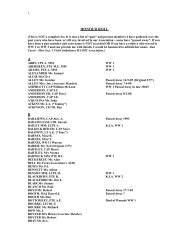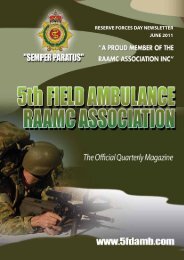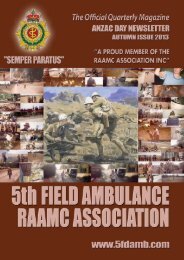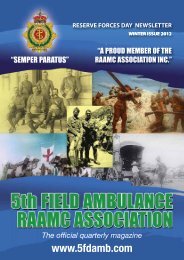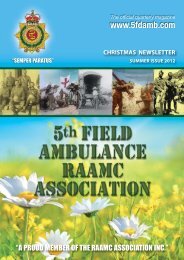2010 Paulatim Magazine - RAAMC Association
2010 Paulatim Magazine - RAAMC Association
2010 Paulatim Magazine - RAAMC Association
Create successful ePaper yourself
Turn your PDF publications into a flip-book with our unique Google optimized e-Paper software.
What is military health and what’s in it for me?<br />
“Medical Operational Capability must be delivered by<br />
personnel who are sufficiently integrated into the<br />
moral, physical and conceptual components of<br />
fighting power in order to be able to conduct their<br />
mission successfully”.<br />
are irreversible. These effects are far more critical than in many<br />
other logistic functions.<br />
• Ethical Issues. A moral dilemma can occur whilst a military health<br />
professional is deployed. This dilemma occurs where application of<br />
oaths, clinical obligations of registration are conflict with military<br />
service creating friction e.g. care of civilians.<br />
PAULATIM<br />
You may of heard our non-health brethren say “what is this black<br />
magic, military health is just like RAEME equipment chain, isn’t it?”<br />
The reality is military health is unique and many articles within this<br />
magazine highlight the key differentiators, some emotively.<br />
fundamental difference is that we cannot remove the human from<br />
health delivery. I would like to discuss what is different about military<br />
health, what challenges face the ADF and what you must do to make a<br />
difference.<br />
Military Health development for each of us is a work in progress, and<br />
yet is a basic skill area; I believe that any military health professional<br />
has key components to improve unit outcomes and satisfaction.<br />
I classify these as Military (all corps requirements), Military Health<br />
(key components) and Specialist (principal specialist skill-set).<br />
These skills may appear in conflict but through diligence enable a<br />
balanced approach to employing skills on the work place. One example<br />
of this conflict is the provision of clinical support to civilian casualties<br />
whilst in uniform. These skills over time contribute to the required<br />
competency for any military health professional to deploy at various<br />
levels. What makes us unique, and truly different should be what we<br />
take to our workplaces, they include but are not limited to:<br />
• Legal Status. The Geneva Conventions, and Defence acts confer a<br />
number of rights and duties on Australia. These duties and rights<br />
apply to each of us by virtue of acts of parliament and are<br />
therefore enshrined in Australian law. Any lack of compliance can<br />
therefore be punishable by law. These are designed to provide<br />
freedom of health delivery on a battlefield. There is a requirement<br />
to provide care to all casualties, irrespective of origin.<br />
• Clinical Prioritisation. Another principal of the Geneva Conventions<br />
is that priority is based solely on clinical need rather than the<br />
operational importance of individuals or their origin. Casualties are<br />
sorted into their priority groups using a system known as triage.<br />
• Casualty Deterioration. Unlike damaged equipment, casualties<br />
cannot be left for periods of time without deteriorating.<br />
• Standards of Care. The standard of medical care provided has a<br />
permanent effect on the medical outcome of casualties. Delayed or<br />
poor quality care cannot be reversed after the event; many effects<br />
• Continuity. Continuity includes both clinical and information<br />
continuity:<br />
°<br />
°<br />
• Time.<br />
°<br />
°<br />
°<br />
Clinical Continuity. Once health has been compromised medical<br />
care must be delivered continuously and progressively to<br />
ensure optimum results. Some casualties will need rapid<br />
evacuation to other health facilities. Continuous links should be<br />
maintained to allow casualties to be transferred. This is unlike<br />
the other logistic functions where continuous links may be<br />
unachievable for all or part of an operation or campaign.<br />
Information Continuity. Clinical continuity is underpinned by<br />
information continuity. This has two aspects, access to<br />
individual clinical data via patient records and direct<br />
communications between attending clinicians. Agreed protocols<br />
reduce the requirement of the latter.<br />
Medical planning is based on time rather than distance per se.<br />
Time taken to reach expert treatment will influence survival<br />
rate, complication rate, rate of recovery and in the longer term<br />
the ultimate quality of life of the casualty.<br />
Within the logistic chain, prioritisation of additional transport<br />
can speed up the delivery of supplies by increasing the lift<br />
available. Faster evacuation means or intermediate medical<br />
staging facilities are required if the clinical timelines are to be<br />
met and continuity of care delivered.<br />
The clinical timelines for land-based operations dictate that the<br />
medical operational timeline is that of the current battle<br />
requiring constant regulation of casualties. This differs from<br />
logistic support/supply planning which aims to resource battles<br />
in advance, or recovering equipment from previous battle and<br />
is focused on the next battle.<br />
• Space. Although the terms ‘forwards’ and ‘rearwards’ are less<br />
clearly defined in a non-linear battle-space, they retain some utility<br />
when discussing the relationship of units and facilities to<br />
operational activity. In terms of space, the medical effort is<br />
‘forward’ because that is where most casualties are generated.<br />
By contrast the main logistic support/supply effort is ‘rearwards’<br />
because that is from where stock is held, controlled and dispatched.<br />
PA U L AT I M – M A GAZINE O F T HE R OYA L A U S T R A L I A N A R M Y M E DICAL C O R P S – 2 0 1 0 8 7



